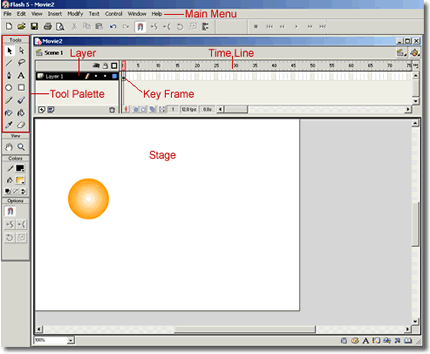|
Flash
Inserting Key Frames |
Exporting Shockwave |
Going Further
Most of the software that we have used to illustrate Web
techniques has been either freeware or shareware. This choice
has been deliberate; to illustrate that one does not have
to use expensive commercial software to do basic web educational
development (but more sophisticated commercial software
can certainly help with both with efficiency and quality
if you do serious development). In the present case we make
an exception and discuss a piece of commercial software,
Flash from Macromedia, because there is no freeware or shareware
(and very little commercial software) that can rival it
for producing sophisticated looking animation with a minimal
learning curve. It is not that expensive (typically $100
or less with an educational discount), and presently you
can download a free 30-day trial version from http://www.macromedia.com.
Note that the plugin to play Flash is free (it can be downloaded
from the Macromedia site given above). The program to produce
Flash movies is the commercial product that we refer to
here.
We are going to show you just enough to illustrate the
power of the program. Specifically, we will show you how
to make a basic animation and how to export and embed the
animation in a Web page as a Shockwave file. That will be
enough to suggest the kinds of uses that Flash Shockwave
could be put to in your own Web development. Our discussion
will be in terms of version 5 of the program (this version's
interface and capabilities differ substantially from those
of earlier versions). We will assume that you have both
Flash 5 and the Flash 5 plugin installed on your computer,
and that you are familiar with the usual simple drawing
tools found in many computer programs (arrow selection tool,
rectangle drawing tool, . . .).
The Flash 5 Interface
The main interface for the program is illustrated in the
following image. We have labeled a few features that will
be used in the examples discussed later. Refer to the program's
help files (available under "Help" in the main menu) for
a more extensive discussion of the many features that we
will not discuss in this short introduction. (The menu also
provides access to a number of tutorials that can help you
learn to use many features of Flash.)

Creating a Symbol to
Animate
Open a new file by selecting "File > New" from the
upper left corner of the main tool bar. The opening screen
reveals a large white area called the stage. The stage is
a work area where you can create and then manipulate images.
Set the stage size and background color by choosing "Modify
> Movie" (i.e., "Movie" under the main "Modify" menu).
In the resulting dialogue box, select 550 for the width,
400 for the height, and a color other than white (say a
gray) for the background color.
Use the circle drawing tool (see the tool palette in the
above image) to draw a small circle on the stage; if it
is not filled, use the paint bucket tool to fill it with
a color. (In the figure above the circle has been filled
with what is known as a radial gradient fill. But you may
choose a simple solid color if you wish. The choice of fill
will not affect the rest of this example.) Select the outline
of the circle with the arrow tool and delete it (simply
press the backspace key while the outline is selected),
leaving just the filled interior.
One of the main uses of Flash is to animate images, whether
they are letters, numbers, or graphic shapes. In order to
be able to do that, we must be able reuse images. The way
we do this is by defining images as symbols.
Convert the circle that you drew to a symbol by selecting
it with the arrow tool and choosing "Insert > Convert
to a Symbol" from the menu. In the resulting dialogue box,
choose "Graphic" for the symbol type, and give it a name
(whatever you would like). A small "+" now appears in the
center of the circle, indicating that it is a symbol.

You should save any computer work on a regular basis, so
this is a good time to save what you have done so far. Choose
"File > Save" and in the resulting dialogue box choose
a directory and a file name (the Flash movie is saved with
an extension .fla by default).
|